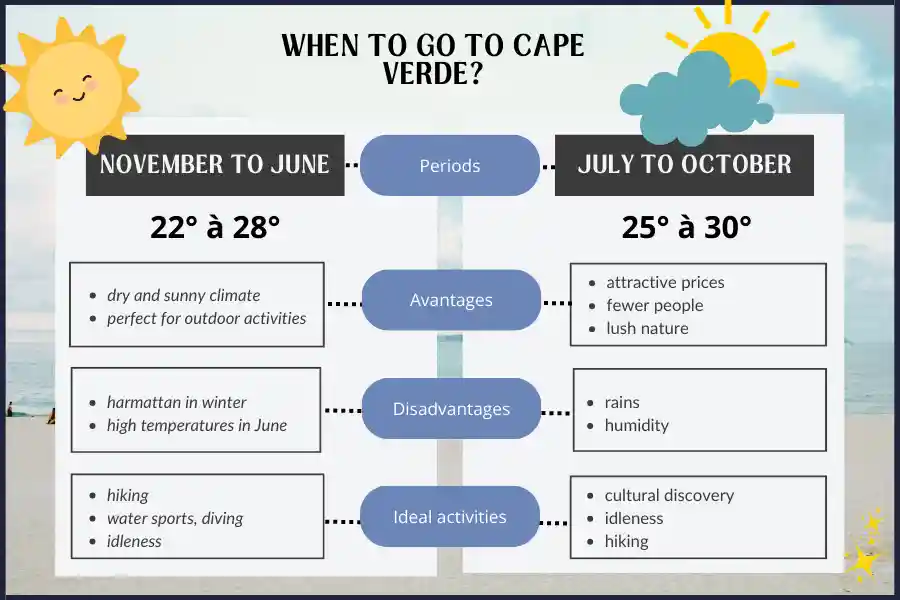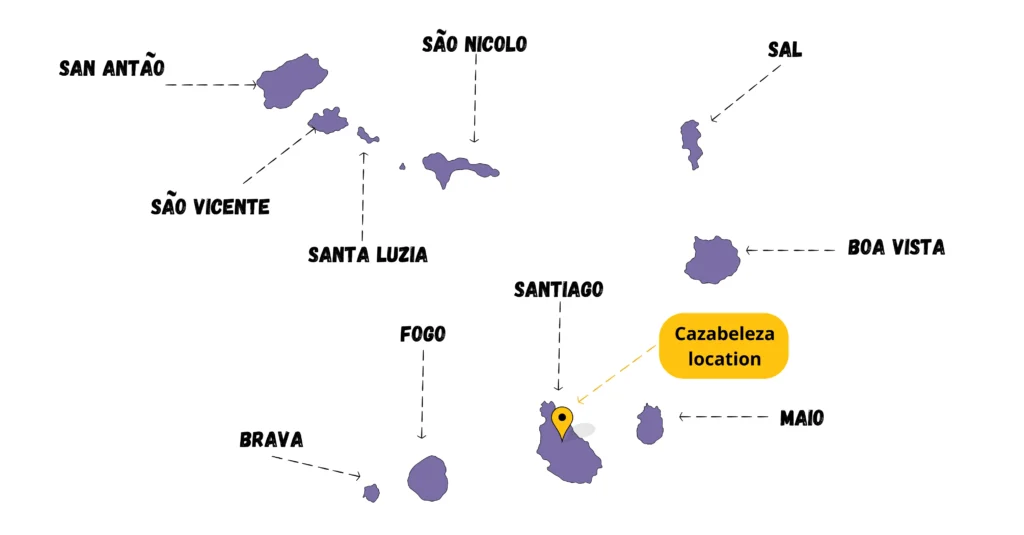Planning your trip to Cape Verde: the ultimate guide 2025
Cape Verde, an archipelago of ten volcanic islands bathed by the turquoise waters of the Atlantic Ocean, is a dream destination for travelers in search of authenticity. With its white sandy beaches and mixed-race culture, this paradise requires careful preparation to take full advantage of its wonders. In this guide, you’ll find all the information you need to plan your trip to Cape Verde.
Table of contents
Why choose Cape Verde as your travel destination?
Whether you’re a lover of paradise beaches, passionate about culture or eager to discover new things, Cape Verde offers a unique travel experience that’s sure to win you over. Each island has its particularities. We help you choose which islands to visit in this article. Here are the main reasons why this archipelago is such an exceptional destination.
An ideal year-round climate
Cape Verde enjoys a particularly pleasant dry tropical climate, with temperatures fluctuating between 20°C and 30°C all year round. Bathed in constant sunshine, the archipelago has two distinct seasons: a dry season from November to June and a rainy season from July to October. The trade winds, gentle and steady, temper the heat and provide ideal conditions for nautical activities. This climatic stability makes Cape Verde an ideal travel destination, whatever the season.
An unique culture between Africa and Portugal
Cape Verde fascinates with its unique cultural mix, the fruit of its history between Africa and Portugal. This richness is reflected in every aspect of Cape Verdean life: language (Cape Verdean Creole), music (the famous morna, a UNESCO World Heritage Site), gastronomy and architecture. The inhabitants, known for their legendary hospitality, perpetuate ancestral traditions while embracing modernity. This cultural authenticity is experienced daily in the bustling streets of the cities as well as in the most remote villages.
Breathtaking landscapes
Each island in the archipelago offers unique and contrasting panoramas. From the volcanic black sand beaches of Fogo to the golden dunes of Boa Vista and the verdant mountains of Santo Antão, Cape Verde is a festival of spectacular landscapes. Nature lovers will find plenty to do, from hiking in lush valleys to exploring majestic volcanoes and discovering unspoilt coastlines. Heavenly beaches with crystal-clear waters are a delight for swimmers and water sports enthusiasts, while sunsets over the ocean offer unforgettable moments of contemplation.

When to go to Cape Verde The best periods
Choosing the ideal time for your trip to Cape Verde will depend on what you want to do and when. Here’s all the information you need to plan your trip at the right time.
Dry season vs. rainy season
The dry season in Cape Verde (November to July) is considered the best time to visit the archipelago. Temperatures are pleasant, the sun is out and the skies are often clear. This season is ideal for :
- Hiking: the trails are passable and the scenery is magnificent under a radiant sun.
- Water sports: the wind blows regularly, making it the perfect time of year for surfing, kitesurfing and windsurfing.
- Scuba diving: underwater visibility is excellent, and the waters are calm.
- Relaxation: The beaches are magnificent and the temperatures invite you to relax.
However, it should be noted that :
- December to February: the harmattan, a dry, hot wind from the Sahara, can blow over the archipelago, making the air more dusty.
- June: this is the hottest month of the year, with temperatures that can exceed 30°C.
Cape Verde’s rainy season from July to October is generally less popular with tourists, but it does offer a few advantages:
- Fares: hotel and flight prices are often more attractive.
- Fewer people: beaches and tourist sites are less crowded
- Nature: the vegetation is more luxuriant, and the landscapes are greener.
However, we expect :
- Showers: rains are generally short and intense, but can disrupt certain activities.
- Higher humidity: the climate can be heavier and less pleasant.

Events and festivals not to be missed
Cape Verde vibrates to the rhythm of numerous festivities throughout the year. Here are some highlights not to be missed:
- Mindelo Carnival (February or March): an explosion of color, music and dance in the streets of São Vicente, often compared to the famous Rio Carnival.
- Music Festival (June): a not-to-be-missed festival on the island of Santiago, celebrating the richness of Cape Verdean music.
- Beach festivals (July-August): festive events on the beaches of Sal and Boa Vista, mixing local and international music.
- São João Festival (June): a particularly lively traditional celebration on the island of São Nicolau
- Baía das Gatas Festival (August): one of the archipelago’s biggest music festivals, attracting artists from all over the world.
These festivities are a unique opportunity to immerse yourself in Cape Verdean culture and share authentic moments with the locals. Remember to book your accommodation in advance if you plan to take part in one of these events, as accommodation is in high demand during these periods.
Formalities and preparations for your trip to Cape Verde
To make the most of your stay, it’s essential to prepare your trip properly. Here are the essential points to know.
Cape Verde visa and necessary documents
A visa is required to enter Cape Verde. Since 2019, the authorities have introduced an electronic visa system (e-Visa) to make the process easier. You can obtain it online for around €30. For your trip, remember to have:
- A passport valid for 6 months after your return
- Tourist visa
- Travel insurance (strongly recommended)
Health and recommended vaccinations
No vaccinations are required for Cape Verde. However, it is recommended to be up to date with your basic vaccinations and to bring :
- Effective mosquito protection
- High-index sun cream
- Basic first-aid kit
Budget and local currency in Cape Verde
The local currency is the Cape Verdean escudo (CVE). Plan on an average budget of €70 to €100 per day, depending on your travel style, including :
- Accommodation: €30-80/night
- Meals: 10-25€/day
- Local transport: 5-15€/day
- Activities: 20-50€/activity
Which islands to visit in Cape Verde?

Cape Verde is an archipelago of astonishing diversity, with each island offering a unique experience. From pristine white sand to lunar volcanic landscapes and lush green mountains, there is something for everyone. But then, how do you choose the island that suits you best? Here is an overview of the most popular islands to help you start your thinking: (scroll the table from left to right on mobile)
| Îsle | Type of beaches | General atmosphere | Main activities | Why choose this island? |
|---|---|---|---|---|
| Santiago | Varied (black, white sand) | Historical, local | Culture, history, hiking, capital Praia | Water sports (kitesurfing, diving), nightlife |
| Boa Vista | White sand, vast expanses | Calm, relaxing | Beach, turtle watching, hiking in the dunes | Represents calm, nature and vast expanses |
| Santo Antão | Varied (beaches, cliffs) | Authentic, natural | Hiking, mountainous landscapes | Depicts mountainous landscapes and hiking |
| São Vicente | Varied (sand, volcanic) | Authentic, natural | Music, festivals, nightlife in Mindelo | Represents culture and nightlife |
| Sal | White sand, turquoise waters | Lively, touristy | Water sports (kitesurfing, diving), nightlife | Represents dream beaches and seaside tourism |
Would you like to know more about these islands and others? Take a look at our article on which island to choose for your vacation in Cape Verde.
How to get around Cape Verde?
Traveling between and on the Cape Verde Islands requires good organization. Here is the essential information to plan your trips. You will find more information on this subject in our guide dedicated to how traveling in Cape Verde during your trip.
Inter-island connections
Two main options are available to you:
- The plane: the Binter CV company provides regular flights between the islands. Book early for the best prices (60-100€/trip)
- The boat: ferries operate on certain islands. It is a more economical way (15-30€/trip) but the times depend on the weather.
Local transport
To move to each island:
- Aluguer (shared taxi): The most economical and authentic way (1-3€/trip)
- Taxi: Practical in town, negotiate the price before departure
- Bus: Available on the main islands, they are infrequent but economical
Vehicule rental
If you opt to rent a car:
- Budget: 40-60€/day
- International license recommended
- 4×4 recommended for some islands (Santo Antão, Fogo)
Experiences not to be missed in Cape Verde
From hiking to culinary pleasures, here are the essential experiences to discover all the facets of Cape Verde.
Hikes and nature activities
Nature lovers will be delighted. Here are some ideas:
- Hiking in the Paul Valley (Santo Antão), between plantations and cliffs
- Ascent of the Pico do Fogo volcano (2,829m)
- Turtle watching in Boa Vista (July-October)
- Discovery of the Pedra Lume salt pans in Sal
- Exploring the green oases of Ribeira Grande, called Povoação by its inhabitants on the island of Santo Antão
Beaches and water sport
Live great experiences in the seaside beaches of Cape Verde:
- Kitesurfing in Santa Maria (Sal), world-renowned spot
- Diving in the caves of Buracona (Sal)
- Swimming on Santa Monica beach (Boa Vista), 18km of white sand
- Big game fishing around São Vicente
- Surf the waves of Ponta Preta (Sal)
Gastronomy and local specialties
In terms of gastronomy, you will not be disappointed. Taste the country’s local specialties. Choose local restaurants over tourist establishments for an authentic dining experience and more affordable prices
- Catchupa: national dish made from corn, beans and fish/meat
- Grilled seafood by the sea
- Grogue: traditional local rum
- Queijo de cabra: local goat cheese
- Doces: Portuguese-inspired pastries
Practical advice for a successful stay
We share with you some essential information to organize and make a success of your stay in Cape Verde.
What to put in your suitcase?
Here is an idea of the essentials to plan:
- Light cotton clothing
- Hat and sunglasses
- Swimsuit and beach towel
- Good walking shoes
- Sunscreen factor 50 (very expensive locally)
- Effective mosquito repellent
- Small basic pharmacy
Safety and best practices
Cape Verde is a safe destination, but stay vigilant by following these tips:
- Avoid flashy jewelry and valuable items
- Prefer official taxis at night
- Drink only bottled water
- Respect local people by dressing decently
- Ask permission before photographing residents
- Keep a copy of your important documents with you
Useful apps for your trip
Download these apps or their equivalents. They could be very useful to you:
| Recommended apps | Fonctionnality |
|---|---|
| Maps.me | online maps of islands |
| XE Currency | convert Cape Verdean escudos |
| Google Translate | translate words into portuguese |
| Cabo Verde Airlines | tracking of inter-island flights (but don’t hesitate to compare with competitors) |
| widely used locally to communicate with tourist agencies |
Cape Verde offers you a unique travel experience, between heavenly beaches, vibrant culture and spectacular landscapes. With this guide in your pocket, you now have all the keys to prepare your stay and explore this enchanting archipelago. Don’t wait any longer, the Cape Verdean adventure is waiting for you!
